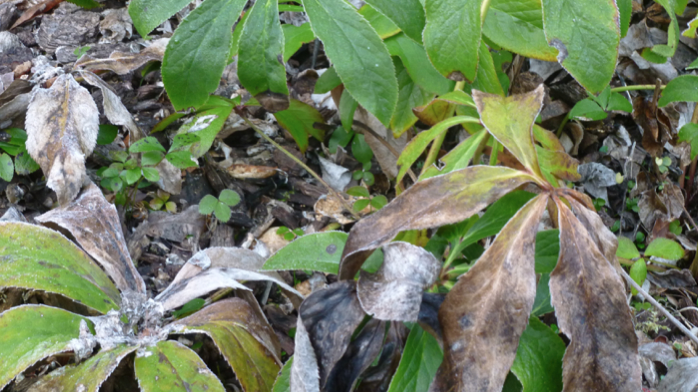Frost
How does frost injure plants?
Frost injures plants by causing ice crystals to form in plant cells. This makes water unavailable to plant tissues and disrupts the movement of fluids. Frost-damaged leaves appear water-soaked, shrivel, and turn dark brown or black.
Plants are rated according to the lowest temperatures they normally tolerate. "Hardy" plants tolerate some short-term freezing. "Tender" plants are killed or injured by freezing temperatures. Citrus, tomatoes, geraniums, bougainvillea, fuchsias and succulents are tender plants. The degree of frost injury depends on the length of the cold snap and the degree of temperature drop. Most plants suffer if temperatures fall below 25°F.

Site selection is important!
• Elevation, soil properties, canopy cover, and the nearness of structures or plants can all affect heat spread within your garden.
• Avoid planting tender species in open areas or in low spots where cold air settles.
• Place frost-tender plants near a south or west-facing wall as these walls absorb heat during the day and radiate it at night.
• Fences, boulders, and shrubs also can serve a protective function for nearby plantings.
Defensive measures
Water the soil thoroughly (except around succulents). Wet soil holds heat better than dry soil, protecting roots, and warming air near the soil.
Provide cover - Bed sheets, drop cloths, blankets, and plastic sheets provide covers for vulnerable plants. Use stakes to keep material, especially plastic, from touching leaves. Remove the coverings when temperatures rise the next day.
Temporary mulch - For a short cold period, low plantings can be covered with mulch, such as straw or leaf mold. Remove once the danger of frost has passed.
Add warmth - Place an outdoor use 100-watt lamp in the inner branches of a small tree. It can emit enough warmth to reduce frost damage. Holiday lights (not the LED type) can also provide warmth but be sure they do not touch any covering materials.
Commercial cover spray - Ask your local nursery for a product that reduces water loss and spray it on the leaves of cold-sensitive plants to seal in moisture. One application can coat the leaves and protect up to three months.
Cluster potted plants close together and, if possible, in a sheltered spot close to the house.
Succulents need special care:
• Check hardiness - While some succulents like stonecrops are very cold hardy, others are quite sensitive.
• Consider keeping them mobile - If the temperature frequently dips below freezing in your garden, consider keeping them in pots so you can move them indoors or to a sheltered location.
• Keep them dry - Whether your succulents are in pots or in the ground, try to keep them on the dry side.
Leave damaged leaves till later - When plant cells are plump with water, they are more likely to burst if the water freezes. Do not remove damaged leaves unless they start to decay. Leaving them in place protects lower foliage.
Plants can be remarkably resilient. If you see signs of frost damage:
• Be patient - Do not prune off the affected parts or dig up the plant immediately. This is especially true for palms.
• Wait until the weather warms up in March to see whether new leaves sprout. When you see healthy new growth at the base of the plant, prune out the damaged parts.
• Remove and replace if necessary - If no regrowth is noted, remove the dead plant and replace it with a more cold-tolerant species.
For more information:
• UC publication Frost Protection for Citrus and other Subtropicals is available at no cost.
• Sunset Western Garden Book contains hardiness of various species.
